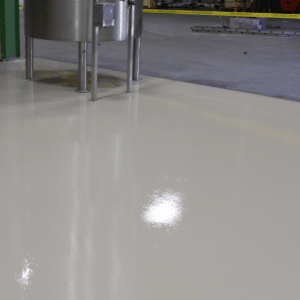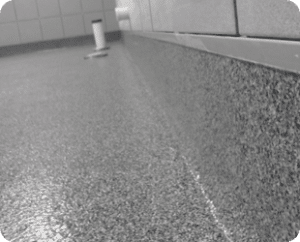Epoxy Coating Guide
Epoxy Coating Guide
- Smooth Finish – Smooth and seamless finish using a polymer based additive.
- Non-Slip – An epoxy floor with a non-slip additive to give the floor grip.
- Mica Pigments (Metallic) Texture – Colored epoxy floor resembling granite and other rocks. Perfect for a natural-looking epoxy floor.
- Granule Textures (Colored flakes) – Epoxy floors with added chips, flakes, or flecks that are water-based resin materials to give the floor extra grip, hide imperfections and add an aesthetic appeal.

SMOOTH EPOXY FLOOR
A smooth epoxy floor finish is the most common type of floor finish you will see in a home garage or basement. Usually its hard to even tell that a nonskid has been applied as most non-skids additives are micronized polymer based powders that are mixed into the epoxy when applied.
Most popular uses
→ Garages
→ Basements
→ Pantries
→ Storage Rooms
→ Playrooms
Feel and look
Desired floor “grip” is achieved by adding more or less of an additive when applying the epoxy coating. It’s important to note that climate and weather conditions play a huge rule in floor grip or texture. In cold conditions where there is alot of water, snow, and ice, ensuring that your floor has a nonskid added it vital. Water on an epoxy floor will simply bubble or bead up depending on the spill amount.
It’s important to clean these spills and areas up as soon as possible to ensure that the floor retains its integrity and these areas do not become the weak spots of your floor. It’s also important to note that after the initial install floors are usually quite slippery. This is alright. The floor needs to be worn in a bit (walked on, driven on, etc.) to gain some wear which in turn strengthens it resulting in a stronger grip. This will happen over time but if you would like to expedite the process then simply use a light floor buffer after install to wear it in.
Pros
- One of the most cost efficient flooring systems on the market. Easy to install and requires little to no experience. Micronized polymer additive still gives the floor the smooth finish but also adds the reliability of a non slip surface.
- Resistant to household cleaners and chemicals.
- Cost Efferent.
Cons
- Not as abrasion resistant as some thicker floor coating systems.

GRANULE TEXTURES AND COLORED FLAKES
Colored flakes have a similar look but are actually water-based resin materials that will help to hide floor imperfections and give it aesthetically pleasing look while adding some texture and thickness to the floor.
Popular Uses
→ Banks
→ Churches
→ Cafeterias
→ Schools
→ Automotive Showrooms
Feel and Look
Granules epoxy floors are made from pure silica sand or quartz. Silica is a hard, abrasion resistance and chemically inert material and ideal for use in custom epoxy floors. High-density silica is the preferred mineral to enhance the properties of seamless flooring. These floors are able to withstand demanding foot traffic while providing decorative granules. Granule epoxy flooring can be customized to match any color scheme. Colors can be mixed and matched to develop a unique color array that best fits your project. In addition to color, the durability and texture can be tailored to the level of surface texture specific to the needs of an environment. Granule textures will feature a transparent, protective layer that provides UV-resistance – perfect for fully exposed, outdoor residential installations, such as a porch.
Pros
- Provides a long-life span.
- Offers a striking appearance.
- Extremely resistant to harsh chemicals and UV rays.
Cons
- Deadening on the broadcast level an additional coat or two might be required to properly cover the floor and ensure all areas are covered.

MICA PIGMENTS (METALLIC) TEXTURE
This epoxy texture is perfect if you want a natural-looking epoxy floor or a unique looking design.
Popular Uses
→ Banquet Halls
→ Bathrooms
→ Grocery Stores
→ Offices
→ Restaurants
→ Restrooms
→ Sunrooms
→ Salons
→ Hotels
Look and Feel
When added to an epoxy floor, color micas give a floor the look of granite and other rocks. This epoxy texture is perfect if you want a natural-looking epoxy floor. Mica nanoparticles are coated with various organic and inorganic pigments to create pearlescent and iridescent effects that mimic the natural look of stone and rock formations. Mica comes in many natural color groups and cleaves nicely into thin sheets that are broken down into various sizes. They also provide a metallic luster that offers alluring shine. These unique pigments are designed to be field blended with a 100% solids clear epoxy binder. When metallic particles are mixed with epoxy, the coat has a shine that reflects light and creates striking color. A micas epoxy floor is an evenly applied, smooth, and glossy surface.
Pros
- Mica’s natural source provides UV stability and colorfast elements.
- Color micas are available in multiple hues.
- Superior chemical resistance.
Cons
- Unable to withstand the demanding traffic of an industrial site.

NON-SLIP EPOXY FLOOR TEXTURE
Non-slip epoxy texture have a rough consistency which creates positive traction and reduces the possibility of slipping and falling.
Popular Uses
→ Restaurants
→ Hospitals
→ Food and Beverage Processing Plants
→ Garage
→ Commercial Kitchens
→ Showers
→ Concrete Floors Where Slip Can Occur
→ Locker Rooms
→ Many Other Manufacturing plants
Feel and Look
Non-slip epoxy floors have a rough consistency which creates positive traction and reduces the possibility of slipping and falling. Non-slip epoxy floors are comprised of various types of aggregate that can be used in conjunction with epoxy resins. Aggregates contain pieces, flakes, or grains that are placed in between layers of epoxy coating to create a non-slip surface. Depending on how a non-slip epoxy is being utilized in an environment, the aggregate can be colored quartz, silica sand, aluminum oxide, plastic media, polypropylene spheres, glass spheres, or walnut shells.
Colored quartz provides a right amount of slip resistance and adds a decorative element to the flooring system. Silica sand provides positive traction where powerful oils and lubricants are used and spilled (this type of aggregate would be used in a machine shop environment. Polypropylene spheres, plastic media, and glass spheres offer adequate slip resistance for facilities with lighter foot traffic and are ideal for areas in which having an easily cleanable surface is required – they provide positive traction without accumulating dirt. For floors requiring rigid slip resistance, aluminum oxide is often applied. Aluminum oxide aggregate is a dense substance when locked in with an epoxy resin, it will still have an angular profile that will provide positive traction. Walnut Shells would be applied in parking decks with elastomeric materials to provide positive traction for vehicles. It can also be used to create a spark-proof floor, unlike silica sand, which does not spark proof.
Pros
- Non-slip epoxy floor texture provides reliable slip resistance to ensure employees are safe in unpredictable environments
- Superior resistance to chemicals, impact, and abrasion
- A first-rate life cycle that provides a cost advantage
Cons
- The more powerful the slip resistance of the epoxy floor, it will be more difficult to clean the floor’s surface. This is due to coating systems with an aggressive slip resistant component, the aggregate that is broadcast into the coating is larger and more angular.
